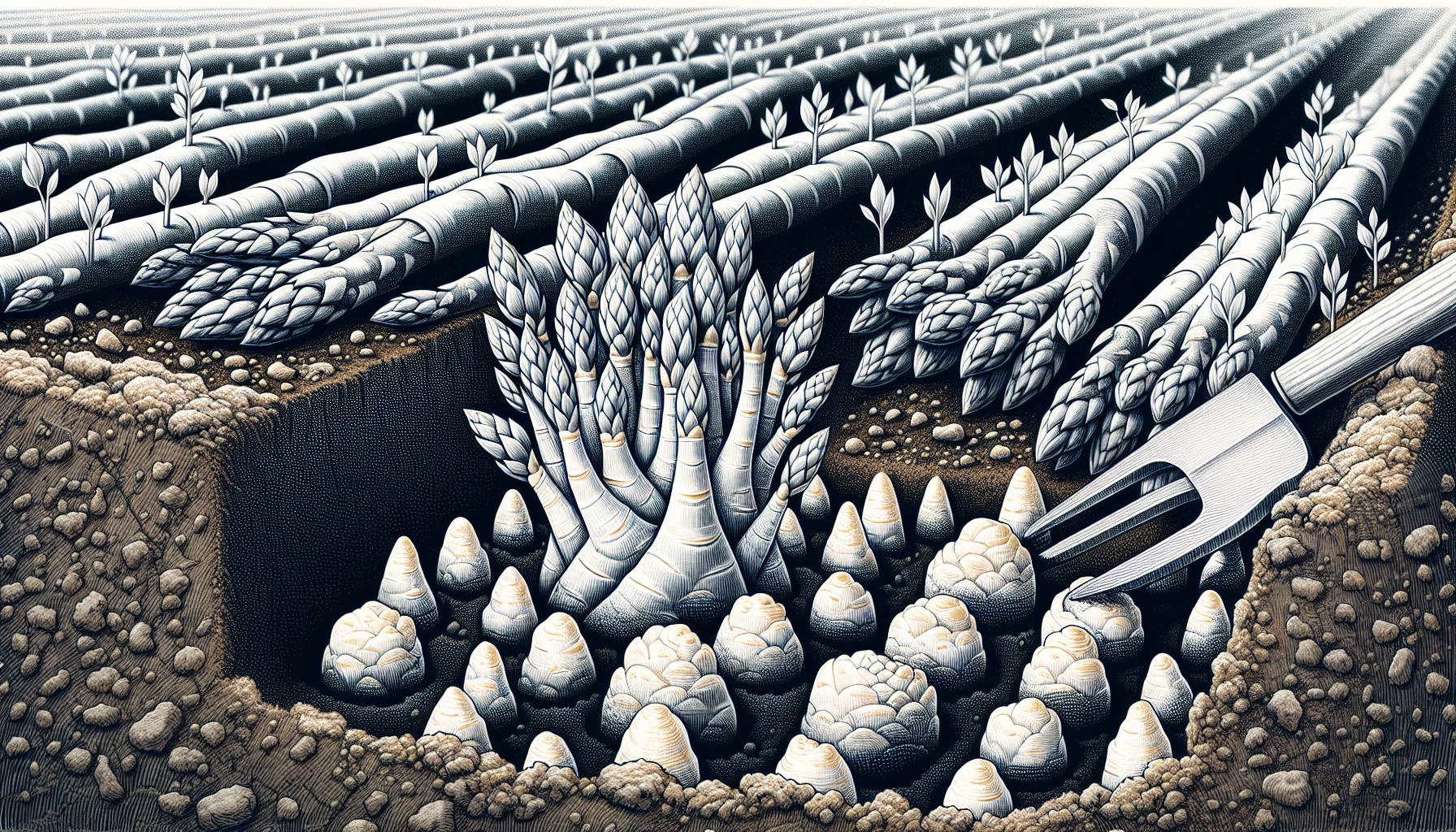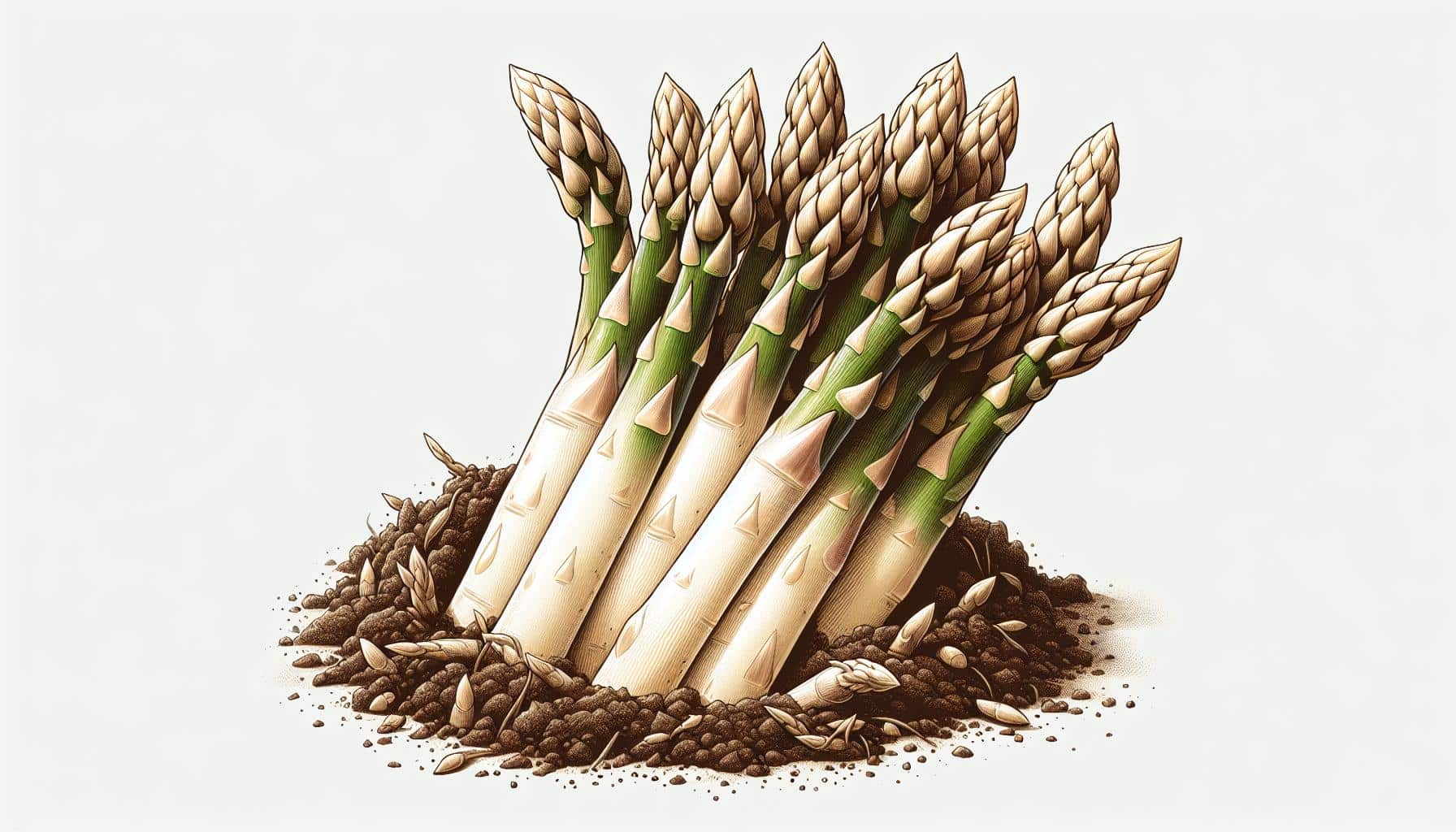
Growing white asparagus is like uncovering a culinary treasure, hidden beneath the soil, away from the sun’s touch. Unlike its green counterpart, white asparagus offers a delicate, slightly sweeter taste and is prized in gourmet cooking. You’ll learn that it’s all about the art of blanching – shielding the spears from sunlight to preserve their ivory hue. With the right techniques and a bit of patience, you’ll be able to grow these pale, succulent spears in your own garden. Ready to investigate into the world of white asparagus cultivation? Let’s get started on your journey to mastering the growth of this unique vegetable.
Choosing the right variety of white asparagus
When embarking on your journey to grow white asparagus, selecting the appropriate variety is crucial. White asparagus comes in different types, each with their specific growth patterns and flavor profiles. You’ll want to choose a variety that not only thrives in your climate but also meets your taste preferences and market demand if you’re considering commercial cultivation.
‘Vitalim’ is a favorite among growers for its high yield and resistance to disease. It’s known for producing thick, sturdy spears that are both tender and flavorful. On the other hand, ‘Gijnlim’ is an early variety, offering a head start to the season, which can be particularly beneficial if you’re selling your crop. It’s important to check the compatibility of these varieties with your soil type and environmental conditions to ensure a successful harvest.
While you may be tempted to select a variety solely based on yield, consider the culinary aspects as well. Chefs and gourmands often look for spears with a delicate flavor, so varieties like ‘Backlim’ are highly sought after for their gastronomic quality.
Remember, white asparagus thrives in sandy, well-drained soil with good aeration. Before settling on a variety, assess your soil’s compatibility or be prepared to make the necessary amendments to accommodate your chosen type. It’s also essential to source your seedlings or crowns from reputable nurseries to guarantee a good start to your cultivation journey.
By making an well-informed choice on the variety of white asparagus, you’re setting the stage for a bountiful and rewarding growing season. Consider the climate, soil, and culinary characteristics when making your choice to ensure you reap the best possible spears from your garden.
Preparing the soil for white asparagus

Before you begin on planting, preparing the soil for white asparagus is crucial. Your future crop’s success depends on this initial groundwork. White asparagus thrives in well-drained, sandy loam soils that are slightly alkaline. First and foremost, you need to test your soil’s pH levels. Aim for a pH between 6.5 and 7.5 to promote optimal growth.
Soil Conditioning
Outfit your garden bed with generous amounts of organic matter. Incorporating aged manure or compost improves soil fertility and drainage – two vital factors for asparagus. These soil amendments should be worked into the soil about 12 to 18 inches deep. As a perennial plant, asparagus will benefit from this initial investment in soil quality for years to come.
Creating Mounds
Your asparagus plants will need mounded rows. Construct mounds that are roughly 8 inches high to allow for adequate drainage. These raised beds not only prevent waterlogging but also aid in warming the soil quicker in the spring, encouraging early growth.
Addressing Weeds
Weed control is imperative when preparing your soil. Asparagus competes poorly with weeds, so clear the area thoroughly before planting. Consider using woven weed barriers which allow water and nutrients to pass through while keeping the weeds at bay.
By ensuring these steps are meticulously followed, you’re setting the stage for a successful white asparagus garden that’s primed for planting. Be attentive, patient, and precise with soil preparation as this determines the foundation on which your asparagus spears will flourish.
Planting white asparagus crowns

Once your soil is ideally prepared, it’s time to turn your attention to planting white asparagus crowns. Select high-quality crowns that are at least one year old, as they are more likely to have a successful yield. Good crowns are crucial; look for ones that are firm and free of rot.
Best Time for Planting
Schedule your planting for early spring when the soil is workable but still cool. Asparagus crowns should be planted as soon as the ground thaws, typically between February and April, depending on your local climate.
Planting Depth and Spacing
Proper depth and spacing are key for optimal growth. Plant crowns:
- Depth: About 12-15 Centimeters Deep
- Spacing Between Crowns: 30-45 Centimeters Apart
- Row Spacing: 1.5 Meters Apart
This spacing allows for ample room for the asparagus to grow and for air to circulate, which helps prevent disease.
Steps for Planting
- Dig a trench approximately 20 centimeters deep.
- Add a small mound of soil in the center of the trench.
- Place each crown on top of a mound, spreading the roots outwards.
- Cover the crowns with soil, leaving a slight mound above ground level to allow for settling.
Water the newly planted crowns thoroughly to settle the soil and eliminate air pockets. As the asparagus grows, gradually add more soil until the trench is filled. This practice encourages the spears to grow straight and makes for easier harvesting.
Starting with Seeds
Though not as common, starting with seeds is an option. If you choose this route, sow seeds indoors about three months before the last frost date. Once seedlings are hardy and the weather cooperates, transplant them outdoors using the spacing guidelines for crowns.
Remember, white asparagus requires patience and care. Regular watering, especially in the first two years, will encourage strong crowns to develop, setting the stage for harvests in the years to come. Your hard work will be rewarded with succulent, tender spears that are a culinary delight. Keep an eye on your asparagus bed and continue to care for it as the spears begin to emerge.
Providing the right conditions for growth

When growing white asparagus, understanding the specific requirements for optimal growth is crucial. Well-drained soil is paramount as asparagus roots are prone to rot in waterlogged conditions. Test your soil’s pH; it should ideally be between 6.5 and 7.5 to encourage the best growth. Adapt your soil by adding lime if necessary.
Full sun exposure is another key factor for successful white asparagus cultivation. Aim for at least eight hours of direct sunlight daily. If you’re in an area with strong sun, protective coverage during the peak hours may prevent overexposure.
Adequately preparing the soil with organic matter or a well-balanced fertilizer promotes strong root development. Incorporate these materials into the soil several weeks before planting:
- Aged manure
- Garden compost
- Bone meal
Watering is essential, yet it must be done correctly. Overwatering can harm the plants, so ensure you provide enough moisture to keep the soil slightly moist but not waterlogged. During the first growing season, your asparagus will need regular, deep watering, especially during dry spells.
Mulching helps retain moisture and control weeds that compete with asparagus for nutrients. Use organic mulch like straw or shredded leaves, and replenish it as needed throughout the season.
Monitor for pests and diseases regularly. Common issues include asparagus beetles and fusarium wilt. Keep a vigilant eye and take action swiftly if you spot potential problems. Safe, effective treatments include:
- Neem oil for asparagus beetle larvae
- Proper crop rotation to prevent fusarium wilt
By providing these right conditions, you’re setting a solid foundation for your asparagus to thrive. Remember, dedication and attentiveness are your best tools to ensure a lush, healthy asparagus bed.
Blanching white asparagus

When growing white asparagus, blanching is a critical process that involves depriving the plants of sunlight to prevent chlorophyll development, which keeps the spears white. To achieve this, you’ll need to be vigilant and cover the asparagus spears as they begin to break through the soil.
Building Your Asparagus Mounds
To blanch your asparagus effectively, start by mounding soil or specially designed asparagus blanching pots over the spears once they’re around 10 cm tall. You need to keep adding soil or adjust the pots to ensure that no light reaches the emerging spears.
Monitoring Growth
As the spears grow, you’ll have to keep a close eye on them. The timing is critical—too early and you won’t have substantial spears, too late and they may begin to develop a green tinge. Regularly check your mounds for any accidental light exposure or spear tips peeking through.
- Use a sharp knife to cut the spear just below soil level – Be careful not to harm any emerging shoots Blanching not only gives white asparagus its unique color but also its milder, more delicate flavor compared to green asparagus. This difference is highly sought after and commands a premium in the culinary world.
Harvesting white asparagus

Harvesting white asparagus requires precision and careful timing to ensure the spears are picked at their optimal quality. Unlike green asparagus, which can be seen above the soil, white asparagus is harvested when the tips are just about to break through the earth’s surface.
Timing Is Key You’ll typically begin to harvest the spears during the spring, from April to June, after the planting crowns have been established for about three years. The exact timing can vary, depending on your regional climate and weather conditions.
Recognizing the Right Moment The ideal time to harvest white asparagus is when the spears are about 6 to 8 inches long and the tips are still compact. Check for any signs of tip opening or purple pigmentation; this indicates that the spears have been overexposed to light and may be starting to develop chlorophyll.
Harvesting Technique When you’re ready to harvest, use a sharp knife or a special asparagus harvesting tool. Gently clear away the soil from around the tip of the spear, then cut the asparagus about an inch below the soil level to prevent damage to the crown and the other emerging spears. This method helps maintain the tender texture and delicate flavor that white asparagus is known for.
Daily Routine Harvest your white asparagus daily during the season. This routine not only promotes a continuous yield but also prevents the spears from growing too large and becoming fibrous. Remember, the fresher the spears are when harvested, the better the flavour you’ll enjoy during your gourmet meals.
Conclusion
Growing white asparagus is a rewarding venture that brings a unique gourmet vegetable to your table. Remember, it’s all about the delicate balance of blanching, precise cutting, and timely harvesting to maintain that sought-after ivory hue and tender taste. Keep a vigilant eye on your asparagus beds and harvest daily for the best results. With the right care, you’ll enjoy the fruits of your labour: succulent, home-grown white asparagus that’s sure to impress.
Colin Macmillan is a seasoned entrepreneur and the CEO of Riverwood Landscape, a leading landscaping company based in Canada. He has been at the helm of the company since leaving high school, demonstrating his strong leadership skills and business acumen.
Colin’s expertise lies in various aspects of landscaping, including lawn care, interlocking, sod installation, and commercial maintenance. His hands-on approach and dedication to the craft have been instrumental in building Riverwood Landscape into a reputable brand.
One of his most notable achievements is the creation of a successful landscape franchise that services multiple locations. This accomplishment underscores his strategic thinking and ability to scale operations effectively.
Colin has also had the privilege of working with Guelph Hospital for landscaping and maintenance, a testament to the trust and reliability that his company has earned over the years.
His professional mission is to offer the best services and experiences for customers, a goal that he tirelessly pursues. Colin’s commitment to excellence and customer satisfaction continues to drive the growth and success of Riverwood Landscape.








